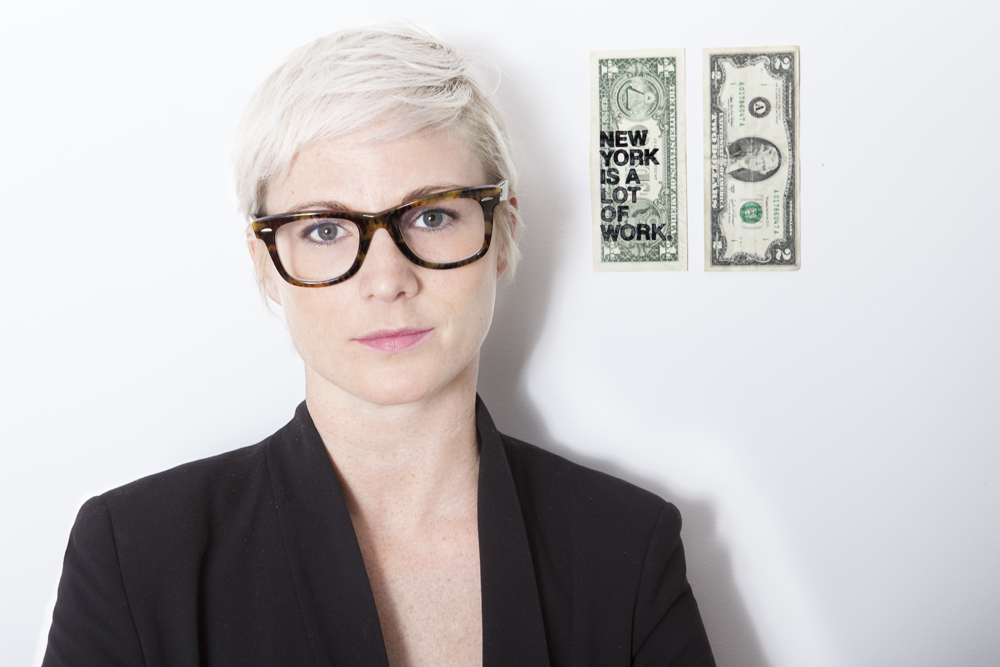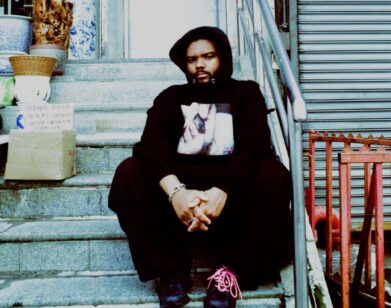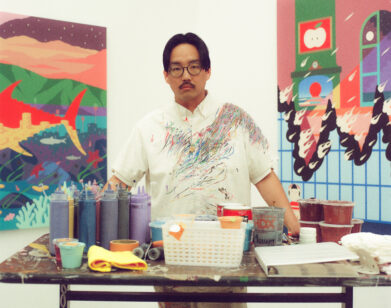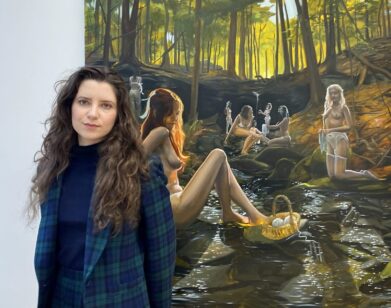Helen Toomer’s Pulse
In May 2014, PULSE Contemporary Art Fair received a makeover–not just because of the artists and galleries presented, but because of the fair’s new director, Helen Toomer. Toomer took the reigns of PULSE in January and by May she had produced a smaller, more intimate and integral showcase at PULSE New York. This week marks the opening of PULSE Miami Beach, where her new direction will continue during Miami Art Week.
Instead of 90 galleries as in previous years, Toomer hand-selected 70, and rather than separating young galleries from established galleries she intermixes them side-by-side. Furthermore, Toomer spoke with each individual gallery to scale back the number of artists presented in its booth. The result is not just another overwhelming fair, but more like a closely curated group exhibition.
“It’s the 10 year anniversary of PULSE,” Toomer says. “I’m excited about that because I’m building on the foundation, but also breathing in new life.”
After a childhood in South Hampton, England, and attending The Arts Institute at Bournemouth, Toomer worked with PULSE from 2004 to 2007. In 2010, however, she left to help develop the website artlog.com, open her own gallery, toomer labzda, in Manhattan’s Lower East Side in 2011, and then serve as Director of Collective Design Fair in 2013. Before the crowds descended in Miami, Toomer told us about her interest in Francis Bacon and curatorial practices.
EMILY MCDERMOTT: I want to talk a little about the fair and then more about your interest in art. First of all, what’s the main difference between the New York show and Miami, if there is one?
HELEN TOOMER: I guess, in essence, the locations and the feel and the energy of each city. In New York, we’re at the Metropolitan Pavilion, which is obviously a building that’s already there. With this, in Miami, it’s the first time we’re going to be in a tent in mid-Miami Beach. There are a lot of things that are continuing in terms of the programming that we started in New York, like the Perspectives roundtable conversations and PULSE Play and the integrated booths with the young emerging galleries and the established galleries. But you know, Miami’s got that different energy, that buzz around it. I’m not saying that New York doesn’t have it, but it’s certainly a different feel.
MCDERMOTT: I know you also had a hand in selecting the artists that each gallery brings. What was that process like?
TOOMER: For me, I had a very hands-on relationship with each of the galleries as well as the committee. So when people applied, we would go back and discuss the artists that they proposed and potentially new ones. For me, that’s one of the most enjoyable aspects–really getting to know how the gallerists’ work with the artists and have a more in-depth view of the artists’ practices. I know some of the artists, but it’s been great to discover new ones and ones that I’ve been very excited about seeing. For example, Rosamund Felsen Gallery is bringing a young artist, John Mills, that I thought looked really great. He’s doing a solo presentation at the fair. I’ve only seen his work online, so I’m excited to see it come alive, and how I, the rest of the team, and the visitors, react to the works in person.
MCDERMOTT: Do you think having such a close relationship with each gallery stems from yourself being a gallerist at one point?
TOOMER: Yeah, I definitely think that helps. I mean, there’s that aspect of having a gallery that I miss–having the close contact with the artists–but I’m a people person, so I love having the dialogue with the gallerist. Also, I can talk to them on somewhat of a level playing field, of having that understanding of how difficult it is to have a gallery. I feel like they’ve been opening up more to me based on that.
MCDERMOTT: I read that when you were 15-years-old you saw Francis Bacon’s Three Studies for Figures at the Base of a Crucifixion. If that was the one moment that truly made you interested in art, what about the painting moved you?
TOOMER: It’s such a weird pivotal moment. I was a creative kid and I was interested in art, but when we went on a school trip to the Tate–before there was Tate Modern–that painting just got me. I couldn’t move. I just sat there. I took it in. Every time that I go back to the Tate Britain I go and spend some time with it. It just brings out an emotion and empathy in me. There’s so much pain…[pauses] I can’t describe it. I think it’s the undoing of human nature, or it highlights the fragility and the turmoil. I don’t know why, but he just, the painting just completely encapsulates all of that. And also, back then it was in the Post-War room, so there were [Alberto] Giacometti sculptures. It was very much a time of struggling, post-WWII, so I feel like I was affected by the feeling of that whole room.
MCDERMOTT: Do you find yourself particularly drawn to post-war art or is there another period that you prefer?
TOOMER: I am drawn to that, but then I’m also drawn to the beauty of Monet and the lilies. Who doesn’t want to look at that? Or sit in the Rothko room? Or, you know, go see the Chris Ofili at the New Museum? I guess I’ve got an eclectic taste. I do love me a little bit of Tracey Emin. It varies, but I think Francis Bacon was just able to, for me, convey such feeling. I think that’s what I responded to.
MCDERMOTT: Is that when you decided art was something you wanted to pursue as a career?
TOOMER: Well actually, that’s when I thought I wanted to be an artist. [laughs] When I walked away from that triptych I thought I wanted to create work that would make people have a reaction like I just had. That was the child like, “I’m going to be an artist!” But I do think, you know, having a gallery and now sort of spearheading PULSE into the future, it’s still something that is about creating an environment that will touch people in different ways by curating artists and galleries and coming together to have an experience. But it’s also subjective. Hopefully, at some point, somebody will get it. [laughs]
MCDERMOTT: Do you find yourself returning to similar themes with your curatorial practices?
TOOMER: I think it changes based on the artists I have conversations with and their thought processes, what they create and where that leads me. I was looking at some of the artists I showed at the gallery, and I still have trouble trying to articulate this, but one of the threads that I had was definitely construction, some sort of architecture, and special elements within that. But no, I guess I just have these gut feelings and tend to run with them and then some logic appears afterwards.
MCDERMOTT: What’s one of those gut feelings that’s recently come into practice? Or a theme that you’ve recently explored?
TOOMER: Well one of the themes that we’re highlighting in the fair is women artists. I think there’s been a lot of talk in that–well, when isn’t there a lot of talk of that? But now it seems to be more, not present, but people taking more note. So I’m excited about Jennifer Dalton’s work at Winkleman Gallery. She’s had a longstanding practice of highlighting the inequality of women in the art world. Then going back to the gut reactions, maybe it’s just when I’ve been looking at work either online or in the gallery, the last time that I had a really great reaction was to the David Altmejd show, the exhibition I just saw in the Musée d’Art Moderne in Paris during FIAC [Foire Internationale d’Art Contemporain]. His work is amazing.
MCDERMOTT: When you’re looking for new artists, or become interested in new artists that you want to promote, what is your process like?
TOOMER: Again, it varies but I’m terribly obsessed with Instagram right now. I can’t stop posting and taking pictures and then I go down the Instagram hole of following a hashtag, and that leads you to a piece of artwork, an artist, or a gallery that you didn’t know about. This year I also went to Madrid during ARCO [Art Contemporary in Spain], London during Frieze, Basel during Basel, and Paris during FIAC, because fairs are an important part of seeing an art community together and being exposed to artists and gallerists I wouldn’t normally be able to see. And, of course, going to the museums and galleries. That’s key for me.
Something that I really am missing, that I haven’t been able to do much this year since closing the gallery and taking on this new role, is artist studio visits. That’s something that’s on my New Year’s resolution list for 2015–making time for studio visits, because that’s one thing I really love doing.
MCDERMOTT: Are there any artists whose studios you really want to see?
TOOMER: There are so many–I mean David Altmejd, that would be a dream studio visit. There’s a bunch of young artists, like John-Baptiste Bernadet. I showed his work with Patrick Brennan in December 2012 and I’d love to go back to both of those studios and revisit, see how they’re doing and see if there’s still a dialogue between their works. Alisa Baremboym is another artist who I think is incredible. It’s just finding the time to see them all.
MCDERMOTT: And go to all of the cities.
TOOMER: I know. One day, one day. [laughs]
MCDERMOTT: So then going back to when you saw Francis Bacon and you thought you wanted to be an artist–when did that shift from wanting to be an artist into the curatorial realm?
TOOMER: Well, I did a Fine Art degree and realized that I was not a good artist. [laughs] But I realized that I really enjoyed organizing our end of year show. We took our end of year show to London and I really enjoyed bringing it into a temporary space, putting together all the promotion, working with the artists, and figuring out the layout and the curation. I realized that I’m just super A-type and like to be organized. Also, I like to promote others that I believe in or really like. So rather than trying to be an artist and not being any good at it, I thought it would be better to work with artists, and now, with galleries.
MCDERMOTT: If you had been going to school for fine art, I imagine that was very creatively minded. So going from that to a very organized position, how did the creative expression translate?
TOOMER: I feel like that’s the battle I had when I was at art school–I would overthink and over organize and over analyze. I think that hindered me creating and making. So actually, I think I tried that creative element, but it didn’t come through enough so I kind of succumbed to it. My mom still asks when I am gonna go back to painting. I’m just like, “Never. Never gonna happen.” [laughs]
MCDERMOTT: Never? You don’t think so?
TOOMER: No, I don’t think so. I mean, I like the idea of it being a creative outlet, and I’d love to be a little old lady in the South of France painting the water lilies during her retirement, but I don’t think so for now. For now I’d rather spend my time enjoying other peoples’ artwork.
MCDERMOTT: So how would you describe your approach toward curation?
TOOMER: Probably feeling and not thinking. [laughs] And then thinking, which is terribly inarticulate, but for me, like I said, it’s a gut feeling and then things come together. It happens. I know that doesn’t sound terribly great when I say it, but…
MCDERMOTT: It’s all about intuition.
TOOMER: Yeah, that’s the word I was looking for. Thanks. [laughs] But yeah, I just trust my intuition. The two artists I mentioned earlier, John-Baptiste and Patrick Brennan, I just saw their works and something clicked in me; I had to show these artists together. They had never been shown together. They didn’t know each other. It just worked and other people made more connections. That’s what I like about [curating] and that’s what I like about art being so subjective and everybody having their own opinions and feelings. My job is really to put it in front of everybody and then let everybody make up their own minds.
FOR MORE INFORMATION ON PULSE, VISIT THE FAIR’S WEBSITE.







